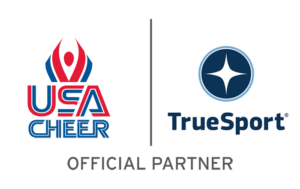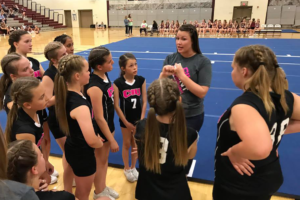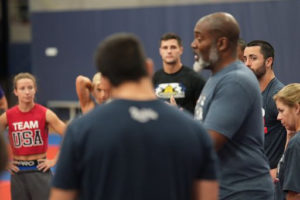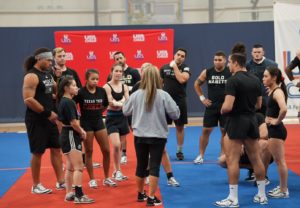What Can Coaches Do To Reduce Resistance and Build Buy-in?
USA Cheer has partnered with TrueSport, to provide new educational tools to equip coaches, parents and young athletes with the resources to build life skills and core values for success in sports and in life. TrueSport, a movement by the U.S. Anti-Doping Agency, inspires athletes, coaches, parents, and administrators to change the culture of youth sport through active engagement and thoughtful curriculum based on cornerstone lessons of sportsmanship, character-building, and clean and healthy performance, while also creating leaders across communities through sport.

What Can Coaches Do To Reduce Resistance and Build Buy-in?

As a coach, you’re often faced with implementing strategic decisions and making tough calls. And just as often, the athletes on your team may resist those decisions or the changes that you’re trying to make. Getting buy-in from athletes isn’t always easy, but it is often critical to the team’s success and your relationship with players.
Here, board-certified family physician and TrueSport Expert Deborah Gilboa, MD, shares strategies for reducing resistance and building athlete buy-in.
Understand what resistance is, and where it comes from
Resistance rarely comes from an athlete who is actively trying to be difficult and find flaws in your proposed plans. “Resistance tends to come when worldviews aren’t aligned,” says Gilboa. You have a view of the world built on your experiences and where you are in life, while athletes have an entirely different worldview.
Resistance can also come from a place of caring deeply about something—and that’s actually a good thing. “Often, athletes are resisting a change that you’re suggesting because they care, not because they’re trying to be difficult,” says Gilboa.
Ask if what you’re hearing really is resistance
 What you see as resistance may not be resistance at all. “Don’t hear every question as resistance: Open your mind to the idea that it might be engagement and not resistance, or it might be collaboration and not resistance,” says Gilboa. “I think coaches often have a strong power structure view in mind. Some coaches think that collaboration and questioning undermine their authority, when actually, if they can stay curious about it, they’re going to find that it increases their respect amongst the athletes.”
What you see as resistance may not be resistance at all. “Don’t hear every question as resistance: Open your mind to the idea that it might be engagement and not resistance, or it might be collaboration and not resistance,” says Gilboa. “I think coaches often have a strong power structure view in mind. Some coaches think that collaboration and questioning undermine their authority, when actually, if they can stay curious about it, they’re going to find that it increases their respect amongst the athletes.”
“As a coach, you need to open your mind to the fact that your athletes questioning you about something may not actually be resistance,” says Gilboa. “That may be how you were conditioned to view it. But it might be the athlete trying to engage, because they’ve been taught to be collaborative. For example, if you say that a set of mats need to be washed off and you’re outside in the field with a hose, your athletes may suggest bringing them into the showers to rinse in warm water instead. That’s not resistance: It’s collaboration.”
Be curious about your athletes
When you think your team isn’t buying into an idea or you’re facing resistance from one athlete, Gilboa says that rather than feeling defensive, try to feel curious. “Assume that you don’t know exactly what’s going on with the team or the athlete,” she says.
“It’s easy to make assumptions, especially when we think we know an athlete very well. But if you can start with curiosity about why they’re resistant to a change you’re suggesting, that helps you understand where they’re coming from, and it can potentially help you reframe your proposed changes in a way that makes more sense to them.”
Ask athletes to help you understand them
Curiosity is important, but so is asking questions of your athletes in a way that doesn’t make them defensive. Gilboa recommends the simple question, “Can you help me understand?” Or “What’s this story for you?” if you’re not sure how to proceed.
From there, you can ask an athlete to share the scenarios that they see playing out. For instance, if an athlete is injured but wants to return to play immediately while you believe they need more time on the bench, let that athlete walk you through the scenarios they see. You may realize that in their mind, another week on the bench will mean no more playing time for the rest of the year, or that a college recruiter will miss seeing them in action and they’ll lose out on a chance for a scholarship. Once you understand where the athlete’s resistance is coming from, you will be better equipped to help them.
Share your perspective

“If your athlete in the above example tells you that he needs to start in the game in order to help the team win, and that he’ll deal with an exacerbated knee injury afterwards, that’s his perspective of what’s best for him and the team,” says Gilboa. “Now, you can share your perspective. As a coach, you may know that if the knee injury the athlete currently has worsens, he might never play again or even have a lifelong knee issue.” Remember, of course, to follow whatever medical recommendations the athlete has received.
Make sure that you and the athlete—or the team as a whole—examine both sides to any story. It’s always helpful to understand where the athlete is coming from, even if you (or a physician) have expertise and insight that leads to a different decision.
Be open to your athletes being right
If you want to reduce resistance and increase athlete buy-in on your team, you will need to be open to the possibility that your athletes may actually be right, and you’re the one who needs to make a change. “A lot of coaches still view resistance as disrespect and they punish it,” says Gilboa. “Older coaches in particular were raised to believe that any questioning of authority was disrespectful. But the current generation of young athletes has been raised to ask questions and share their feelings.”
“So, when a coach says to a group of athletes, ‘I want you to pick up all these mats and take them out in the hallway,’ they may not immediately comply with that request. They may ask why, or suggest a different place to bring the mats,” says Gilboa. “That isn’t disrespect, it’s critical thinking and engagement in the process.”
Be transparent with your team

As coaches, we often want to present fully-formed solutions to difficult problems that a team is facing, without ever sharing the original problem with the team. To you, the solution is a good one—perhaps even the only one—based on your worldview and information. But your athletes may not have the same view or information and may view the change you’re suggesting as unfair. To get buy-in, you need to be transparent and provide all the facts, so that your athletes can form opinions from a more knowledgeable place.
“Give them more transparently sourced information, and be open to hearing their opinions and concerns,” says Gilboa. For example, if a school’s athletic budget has been slashed and you’re faced with combining the varsity and JV teams into one larger team for practices and sharing the bus for competitions, your varsity athletes may not be excited about this idea, especially if you simply tell them that the teams are merging. But if you present them with the facts about the budget cuts and are open to hearing any of their proposed solutions, you’re going to lower their resistance to the changes.
Set a timer
“After you’ve presented a change that athletes may not like, give them five minutes to feel their feelings and express what they hate about it, because change is hard,” says Gilboa. “Once that time is up, you can shift into problem-solving mode and ask athletes if they have other suggestions or solutions. You can offer true empathy, processing time, transparently sourced information, and some choice to help decrease resistance.”
Takeaway
Rather than disciplining athletes who resist your decisions as a coach, lead with curiosity and listen to their concerns. As a coach, you may understand that a change to the team is necessary, but make sure that your athletes understand your reasons and be willing to hear their suggestions with an open mind, remembering that athletes who show resistance aren’t necessarily disrespecting you or your authority.
What is TrueSport?
The TrueSport Champion Network is a community of coaches, parents, program directors, and athletes who believe in the power of youth sport to build life skills and core values for success both on and off the field. Join TrueSport Champion Network to help promote the positive values of cheer, dance, and STUNT!
The TrueSport Coaching Education Program empowers coaches—the most significant influencers in young athletes’ lives—with a transformative learning opportunity to obtain the knowledge and resources to cultivate, champion, and uphold the rich promise and highest potential of sport.
Additional Training Modules from TrueSport
USA Cheer is proud to partner with USADA’s TrueSport® to bring relevant educational content to the Cheer and STUNT community in order to promote a positive youth sport experience. We are excited to provide access to TrueSport’s experts that take coaching beyond skills and help truly develop the overall athlete by building life skills and core values for success on and off the mat, sideline, field, and court.
Feel free to share these resources with your coaching staff, parents, or athletes!
About TrueSport
TrueSport®, a movement powered by the experience and values of the U.S. Anti-Doping Agency, champions the positive values and life lessons learned through youth sport. TrueSport inspires athletes, coaches, parents, and administrators to change the culture of youth sport through active engagement and thoughtful curriculum based on cornerstone lessons of sportsmanship, character-building, and clean and healthy performance, while also creating leaders across communities through sport.
For more expert-driven articles and materials, visit TrueSport’s comprehensive library of resources.
This content was reproduced in partnership with TrueSport. Any content copied or reproduced without TrueSport and the U.S. Anti-Doping Agency’s express written permission would be in violation of our copyright, and subject to legal recourse. To learn more or request permission to reproduce content, click here.



